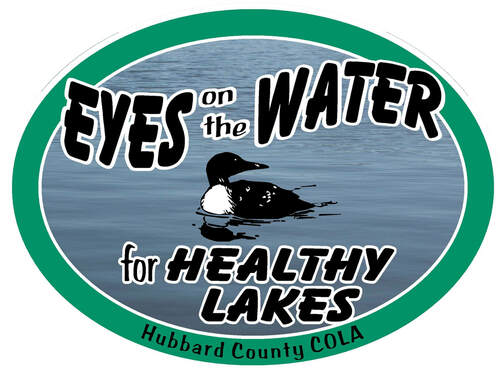Hubbard County Coalition of Lake Associations (HC COLA) is encouraging all lakeshore owners to be your lake's "Eyes on the Water". You could be a "first responder" in locating an aquatic invasive species (AIS) on your lake. This early detection has proven to be an effective way of stemming the subsequent spread of AIS to other lakes. Early detection can also allow for more effective treatment options in your lake for aquatic invasive vegetation and critters.
Zebra Mussel Settlement Samplers (ZMSS) are available for free through Hubbard COLA; email hccolamn@gmail.com. These pvc pipes hang on a rope from your dock below the water's surface about a foot from the bottom of the lake where microscopic ZM veligers (tiny baby ZM unseen by the naked eye) may float by and may settle, cling to, and then grow until you can "see" and "detect" them. The ZMSS is just one of the tools in the toolkit for finding ZM.
In August of each year, HCCOLA will send a link to the on-line survey to past participants to help us evaluate our “Eyes on the Water” efforts. We are always looking for more volunteers so if you would like to be included in this mailing of the survey, please send us a request at hccolamn@gmail.com with your name and lake please. You can also complete the survey by using the link below and you will be included in future mailings. All of us at Hubbard COLA thank you for your efforts to keep our area lakes clean and healthy!
We are grateful to the 4-H shooting sports and wildlife club for assembling so many ZMSS for HCCOLA in 2025!
Click here for the guide: How to use your Zebra Mussel Settlement Sampler (ZMSS) for Early Detection of Zebra Mussels
Click here for Protocols for AIS Lake Monitoring to guide you to look for AIS on your lake. (Special thanks to Dan Kittilson for developing this Eyes on the Water program.)
Zebra Mussel Settlement Samplers (ZMSS) are available for free through Hubbard COLA; email hccolamn@gmail.com. These pvc pipes hang on a rope from your dock below the water's surface about a foot from the bottom of the lake where microscopic ZM veligers (tiny baby ZM unseen by the naked eye) may float by and may settle, cling to, and then grow until you can "see" and "detect" them. The ZMSS is just one of the tools in the toolkit for finding ZM.
In August of each year, HCCOLA will send a link to the on-line survey to past participants to help us evaluate our “Eyes on the Water” efforts. We are always looking for more volunteers so if you would like to be included in this mailing of the survey, please send us a request at hccolamn@gmail.com with your name and lake please. You can also complete the survey by using the link below and you will be included in future mailings. All of us at Hubbard COLA thank you for your efforts to keep our area lakes clean and healthy!
We are grateful to the 4-H shooting sports and wildlife club for assembling so many ZMSS for HCCOLA in 2025!
Click here for the guide: How to use your Zebra Mussel Settlement Sampler (ZMSS) for Early Detection of Zebra Mussels
Click here for Protocols for AIS Lake Monitoring to guide you to look for AIS on your lake. (Special thanks to Dan Kittilson for developing this Eyes on the Water program.)
|
|
Click here for a field guide titled "Aquatic Invasive Species: Methods for Identification & Detection" developed by the DNR. |
The UMN AIS Research Center (MAISRC) has a free downloadable Aquatic Invasive Species Identification Guidebook - click here: maisrc.umn.edu/guidebook
The 2025 "Eyes on the Water" Survey opens August 2025!
Past Survey Results Through 2024!
The reports that can be accessed below is a compilation of results of our on-line surveys and other data on early detection efforts. If you need more detailed information on your lake, please contact HCCOLA at hccolamn@gmail.com
Eyes on the Water Survey Results for 2024
Eyes on the Water AIS Lake Monitoring Results (2017 - 2024)
Note:
The Report below lists Lakes that use a special plankton net primarily during mid June to early July to
sample the entire water column from approximately 11 feet to the surface following the protocol on RMB Lakes Monitoring website area. The water sample then is preserved with 91% alcohol. The sample is delivered to the lab on the HCCOLA volunteer shuttle service and then analyzed by RMB Environmental Laboratory in Detroit Lakes according to the form the Lake monitor writes out and provides to the lab with the sample. The sample may then be analyzed for the presence of zebra mussel veligers and a separate process is used to analyze the same sample of water for spiny water fleas. There is a separate cost for each of these 2 tests. The costs can change from year to year. Lakes may also use a separate plankton net to search for spiny water flea in the water column that are visible to the naked eye based on the MAISRC protocol.
Lakes Monitored for Zebra Mussel Veliger and Spiney Water Flea (2012 - 2024)
AIS Volunteers are Located on Lake Sides for Zebra Mussel Settlement Samplers (2024)
